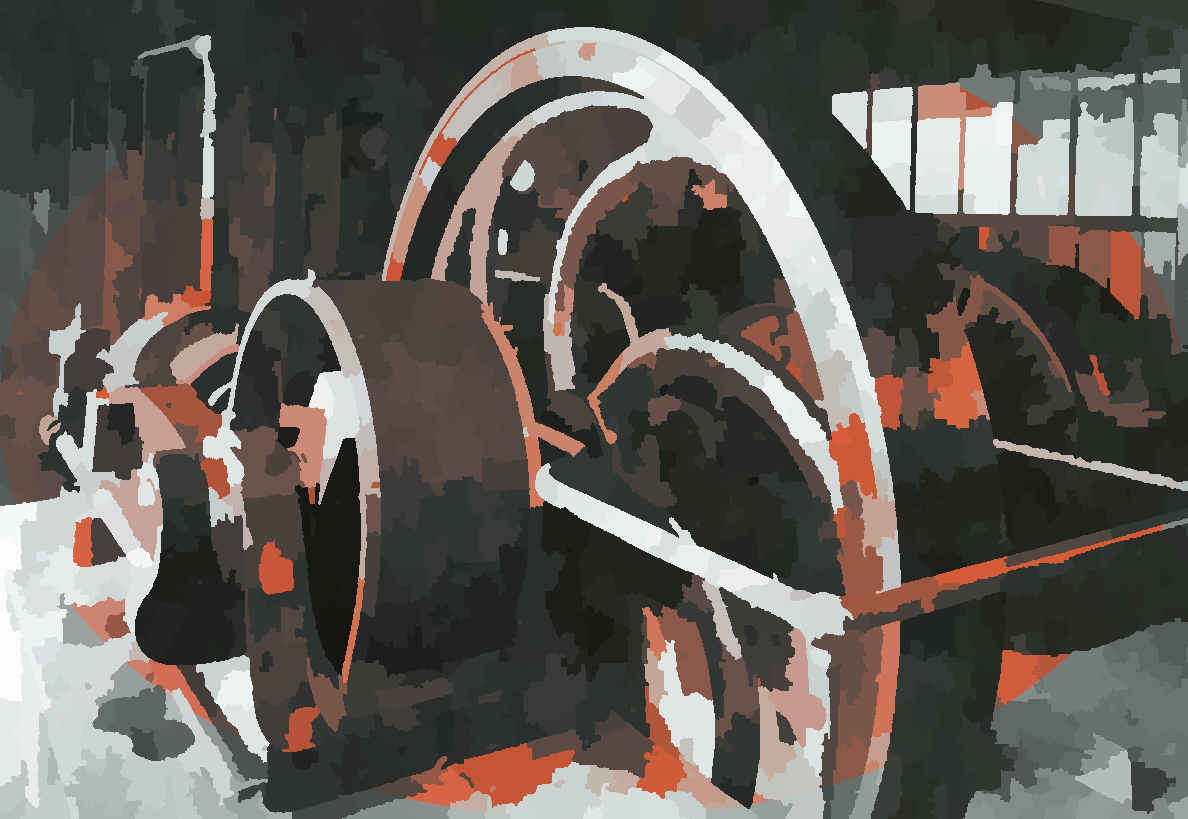|
This
is one of the strangest EV's we've ever seen. Nevertheless, it is an
electric
vehicle. This DIY Dalek uses a 12-24volt DC motor, originally powered by 50 nickel
cadmium batteries wired as 5 x 12v banks. In 2024 this was
replaced with a 12v BMW i3 car battery. Which is lead-acid, and about
the same size as a large motorcycle unit.
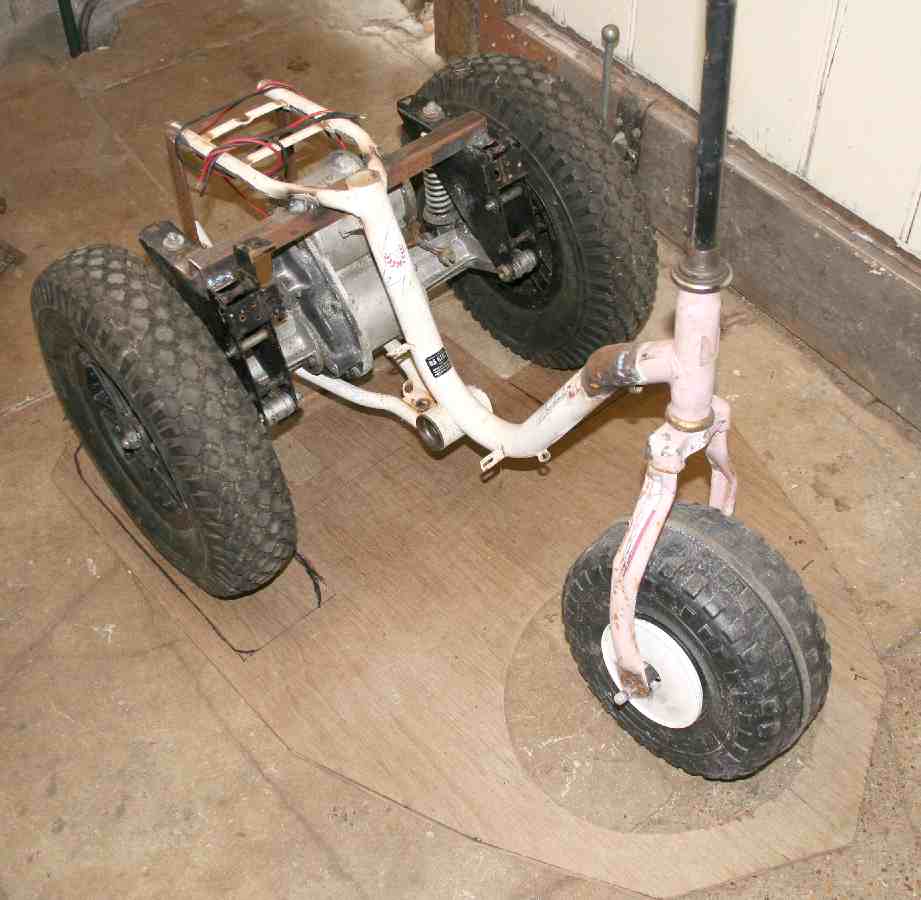
Bicycle
to electric tricycle
This
working full scale model is based on a junior push bike frame, shortened, with the
handlebars replaced by a very much shortened joystick. An electric motor axle unit is
welded to the bike frame to form a trike. You can see the base for
the Dalek's body is cut from 10mm plywood. All of the materials and
components were salvaged and recycled.
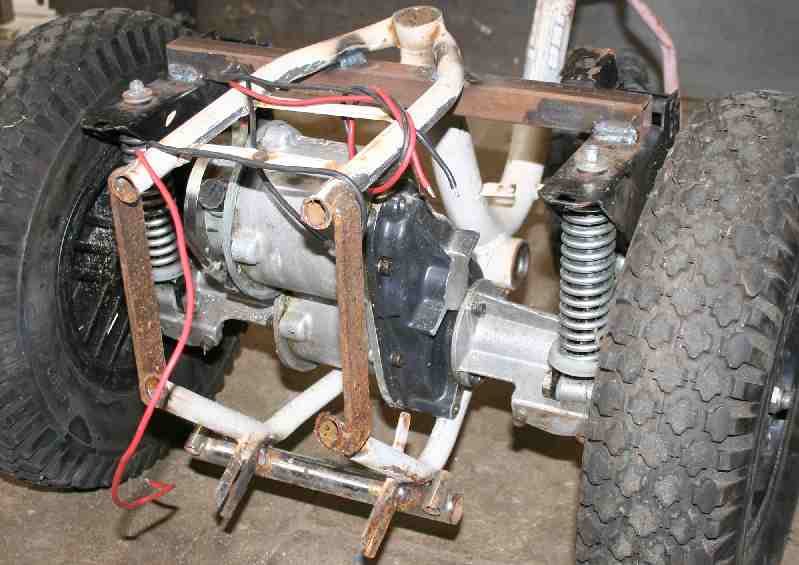
Dalek
motor, differential and rear axle suspension
This
is what happens after
watching the BBC
TV Dr Who series, with time on your hands. If you've
got a workshop and a youngster keen on Daleks - why not. A Seven year
old helped to make this DIY Dalek at weekends and very
much enjoyed the experience - while also learning some valuable
practical skills and that if you want to do something and try hard
enough, you can succeed. The skills learned were: 1) Welding 2)
Woodworking 3) Electrical wiring 4) Drawing to scale.
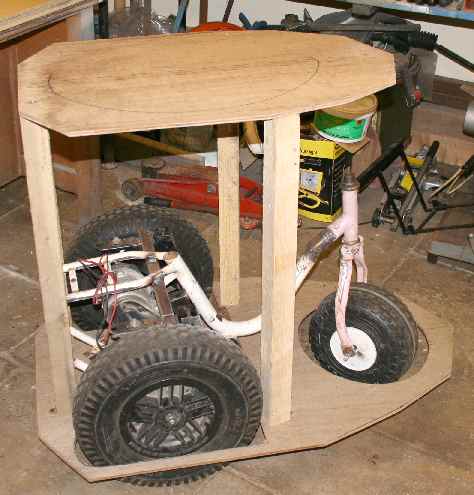
Plywood
body formers bolted to trike frame, plastic front wheel
The wheels fit through slots
in the plywood, which is then bolted to the trike's frame. We hope
it will not be too difficult to attach the remaining bodywork and that
many youngsters and adults will enjoy either driving the Dalek with some
precision, or just sitting in the vehicle - maybe for a selfie.
The
sides of this Dalek were cut from cardboard to make patterns, to be
transferred to aluminium sheet, and then cut and formed. When complete, each side will be
fixed to the
plywood frames and painted.
Daleks
(fictionally) originates from the planet Skaro. They are mutations of a humanoid species who, according to some sources, were called Kaleds. They warred with the Thals, another humanoid race on the planet. The war resulted in a mutated species of Kaleds - the Daleks.
These beings live in outer casings which are basically fighting machines. Daleks have been described as 'emotionless' 'robotic' creatures. Both statements are incorrect. Daleks are quite emotional at times - particularly when exterminating their enemies. And they are living beings, not robots - though they do have an unswerving loyalty to the Dalek cause which may make them seem 'robotic'.
Whilst their favourite phrase appears to be 'Exterminate', they also tend to say 'I obey' quite a lot - particularly when ordered to exterminate. Of course, 'I obey' is a concept universal to the military mind everywhere - though different words might be used, the meaning is the same. Spectrum's 'S.I.G.', the W.A.S.P.s 'P.W.O.R.' and even International Rescue's 'F.A.B.' essentially all mean the same thing - I obey. "I don't think I'll do that sir, if it's all the same to you." isn't generally an option.
The Daleks' strength lies mainly in their selfless, fearless devotion to the Dalek civilisation as a whole. Each Dalek is expendable - for the greater good of the race. Daleks don't sleep, neither do they have any recreational requirements. They are the ultimate soldier.
The Daleks (pronounced "DAH-lecks"; IPA: 'dɑːlɛks) are a fictional extraterrestrial race of mutants from the British science fiction television series Doctor Who. The mutated descendants of the Kaled people of the planet Skaro, they travel around in tank-like mechanical casings, a ruthless race bent on universal conquest and domination, utterly without pity, compassion or remorse. They are also, collectively, the greatest
alien adversaries of the Time Lord known as the Doctor. Their most infamous catchphrase is "EX-TER-MIN-ATE!", with each syllable individually screeched in a frantic electronic voice (download sample). Other common utterances include "I (or WE) OBEY!" to any command given by a superior.
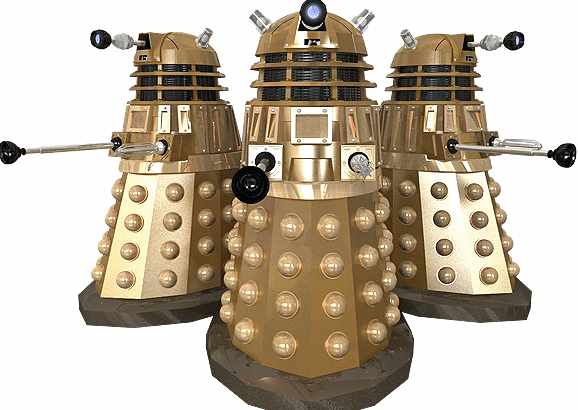
TERRY NATION
The Daleks were created by writer Terry Nation and BBC designer Raymond Cusick and were first introduced in December 1963 in the second Doctor Who serial. They became an immediate hit with the viewing audience, featuring in many subsequent serials. They have become synonymous with Doctor Who and their behaviour and catchphrases are part of British popular culture.
The word "Dalek" has entered the Oxford English Dictionary and other major dictionaries (the Collins Dictionary defines it rather broadly as "any of a set of fictional robot-like creations that are aggressive, mobile, and produce rasping staccato speech"). It is also a trademark, having first been registered by the BBC in 1964 to protect its lucrative range of Dalek merchandise.
The term is sometimes used in a metaphorical sense to describe people, usually figures in authority, who act like robots unable to break their programming. John Birt, the much maligned ex-Director General of the BBC, was called a "croak-voiced Dalek" by playwright Dennis Potter in August 1993. The Daleks even appeared on a postage stamp celebrating British popular culture in 1999, photographed by Lord Snowdon.
Externally, Daleks resemble man-sized pepper shakers, with a single mechanical eyestalk in a rotating dome, a gunstalk containing a directed energy weapon (or "death ray"), and a telescoping robot arm. Usually, the arm is fitted with a device for manipulation that, to the amusement of generations of viewers, resembles a plunger, but various episodes have shown Daleks whose arms end in a tray, a mechanical claw, or other specialised equipment like flamethrowers. In Dalek, the plunger was used to kill by crushing a human skull. The casings are made of a material that has been called dalekanium.
In the alternate future of Day of the Daleks, dalekanium is an unstable explosive that can penetrate Dalek casings. The two may be the same, or the term may simply be a neologism to describe a product of the Daleks . The lower shell is covered with many hemispherical protrusions or "Dalek bumps". These have been described as being a sensor array but in the episode Dalek they are part of a self-destruct system.
The creatures inside their "travel machines" are depicted as soft and repulsive in appearance, but still vicious even without their mechanical armour. In Resurrection of the Daleks a Dalek creature, separated from its casing, attacks and kills a human soldier. The Doctor has described the Daleks as "little green blobs in bonded polycarbide armour." However, as the creature inside is rarely seen on screen, the misconception that Daleks are wholly mechanical robots exists, a mistake the series itself has made on occasion. The interdependence of biological and mechanical components makes the Daleks a type of cyborg.
The voice of a Dalek is electronic, the Dalek creature having no vocal apparatus as such. Daleks also have a radio communicator built into their shells, and emit an alarm to summon other nearby Daleks if the casing is opened from outside. The Dalek's eyepiece is its most vulnerable spot, and impairing its vision often leads to a blind firing of its weapon.
Due to their gliding motion Daleks were notoriously unable to tackle stairs, which made them easy to overcome under the right circumstances. An oft-copied cartoon from Punch pictured a group of Daleks at the foot of a flight of stairs with the caption, "This certainly buggers our plan to conquer the Universe". In a scene from the serial Destiny of the Daleks, the Doctor and companions escape from Dalek pursuers by climbing into a ceiling duct. The Doctor (Tom Baker) calls down, "If you're supposed to be the superior race of the universe, why don't you try climbing after us? Bye bye!" The Daleks generally make up for their lack of mobility with overwhelming firepower. A joke around science fiction conventions went, "Real Daleks don't climb stairs; they level the building."
In The Dalek Invasion of Earth (1964) a Dalek emerges from the waters of the River Thames, indicating that they are amphibious to a degree. Remembrance of the Daleks (1988) showed that they can hover using a sort of limited antigravity — first implied in earlier serials such as The Chase (1965) and Revelation of the Daleks (1985) — but their awkward forms still limit their mobility in tight quarters. Despite this, the Daleks' supposed inability to climb stairs is still frequently referred to for humorous effect by journalists covering the series. The 2005 series episode Dalek also featured a hovering Dalek. In this episode, before hovering, the Dalek said "Elevate" as it would say "Exterminate" before exterminating.
The Daleks were actually operated from inside by short operators who had to manipulate their eyestalks, domes and arms, as well as flashing the lights on their heads in sync with the actors supplying their voices. The Dalek cases were built in two pieces; once an operator stepped into the lower section the top would be lowered onto him. The operators looked out between the circular louvres just beneath the dome that were lined with mesh to conceal their faces.
Unfortunately, as well as being hot and cramped the Dalek casings also muffled external sounds, making it difficult for the operators to hear the director's commands or studio dialogue. The top sections were also too heavy to lift from the inside, which meant that the operators could be trapped in them if the stagehands forgot to let them out.
Early versions of the Daleks were either rolled around on castors or propelled by wheels connected to hand cranks by bicycle chains. Later versions had more efficient wheels and were simply propelled by the operators' feet. Even so, they were so heavy that when going up ramps they often had to be pushed by stagehands out of camera shot. In addition, the difficulty of operating all the prop's parts at once also contributed to the occasionally jerky movements of the Dalek. The latest model of the costume still has a human operator within, but the movement of the dome and eyestalk is now remotely controlled so that the operator can concentrate on the smooth movement of the Dalek and its arms.
The
DIY version shown here is a vast improvement, being electrically propelled,
with forward and reverse switching.
The Dalek voice, a staccato delivery, was initially developed by voice actors Peter Hawkins (who had also provided the voice for the popular children's animated series Captain Pugwash) and David Graham, who would vary the pitch and speed of the lines according to the emotion needed. Their voices were further processed electronically by Brian Hodgson at the BBC Radiophonic Workshop. Although the exact sound-processing devices used have varied over the years, the original 1963 effect used EQ to boost the mid-range of the actors voice, then subjected it to ring modulation with a 30Hz sine wave, and the distinctive harsh grating vocal timbre this produced has remained the pattern for all Dalek voices since then. Notable voice actors for the Daleks include Roy Skelton. In the 2005 series, the Dalek voice is provided by Nicholas Briggs, speaking into a microphone connected to a voice modulator. Briggs has also done Dalek and other alien voices for audio plays.
The non-humanoid shape of the Dalek, unlike anything that had been seen on television before, did much to enhance the creatures' sense of menace. With no familiar points of reference, it was a far cry from the traditional "bug-eyed monster" of science fiction that Doctor Who series creator Sydney Newman wanted the show to avoid. The unsettling form of the Daleks, coupled with their alien voices, also made many believe for a while that the props were wholly mechanical and operated by remote control.
Manufacturing the props was also expensive. In scenes where many Daleks had to appear, some of them would be represented by wooden replicas or even (in early black and white episodes) by life-size photographic enlargements. In scenes involving armies of Daleks, the BBC effects team even turned to using commercially-available toy Daleks, manufactured by Louis Marx & Co. Judicious editing techniques also made it look like there were more Dalek props than were actually available.

DIY
Dalek being tested by adult volunteers
CONCEPTUAL HISTORY
Terry Nation claimed that he was inspired by watching ballet dancers in long dresses glide as if on wheels. Indeed, for many of the shows, the Daleks were "played" by retired ballet dancers wearing black socks while sitting inside the Dalek. Raymond Cusick claims that after Nation wrote the script, he was given only an hour to come up with the design for the Daleks, and was inspired by a pepper shaker on the table in front of him to do the initial sketches (other sources state that he based it on a man seated in a chair, and only used the pepper shaker to demonstrate how it might move).
Nation also claimed that the name came from a volume of a dictionary or encyclopedia, the spine of which read "Dal - Lek". He later admitted that he had made this up as a reply to a question by a journalist and that anyone who checked out his story would have found him out. The name had in reality simply rolled off his typewriter. Later, Nation was pleasantly surprised to discover that in Serbo-Croatian the word "Dalek" means "far and distant thing".
Nation grew up during World War
II, and remembered the fear caused by German bombings. He consciously based the Daleks on the Nazis, conceiving the species as faceless, authoritarian figures dedicated to conquest, domination, and complete conformity. The analogy is most obvious in the Dalek stories penned by Nation, in particular The Dalek Invasion of Earth and Genesis of the Daleks.
Prior to writing the first Dalek serial, Nation was chief scriptwriter for comedian Tony Hancock. The two fell out and Nation was fired. According to various sources, including Cliff Goodwin's biography of Hancock, the comedian claimed that during one of their last meetings he had speculated on how nuclear warfare might reduce humans to such a helpless state that they would have to be plugged into robot-like casings to stay alive. Allegedly, when Hancock saw the Daleks he shouted at the screen, "That bloody Nation — he's stolen my robots!"
The first Dalek serial is called, variously, The Survivors (the pre-production title), The Mutants (its official title at the time of production and broadcast, later taken by a second, unrelated Doctor Who story), Beyond the Sun, The Dead Planet, or simply The Daleks. The reason for the multiple titles is that in the show's early years each individual episode had a different name and overall story titles were used only by the production office. Subsequently, several different overall story titles were circulated by fandom without access to the correct records. See: Doctor Who story title controversy.
The instant appeal of the Daleks took the BBC off guard, and transformed Doctor Who from a Saturday tea-time children's educational programme to a must-watch national phenomenon. Children were alternately frightened and fascinated by the completely alien look of the monsters, and the Doctor Who production office was inundated by letters and calls asking about the creatures. Newspaper articles focused more attention on the series and the Daleks, enhancing their popularity further.
Despite the Daleks' popularity, however, they were forever associated with Doctor Who. Nation, who jointly owned the intellectual property rights to the Daleks with the BBC, therefore had the problem of owning a money-making concept that proved nearly impossible to sell to anyone else and was dependent on the BBC wanting to produce stories featuring the creatures. Indeed, several attempts to market the Daleks outside of Doctor Who were unsuccessful. The sums of money required to pay Nation for the use of the Daleks also explained why their appearances in the programme were rare in later years. Since Nation's death in 1997, his share of the rights now belong to his estate and are administered by his former agent, Tim Hancock.
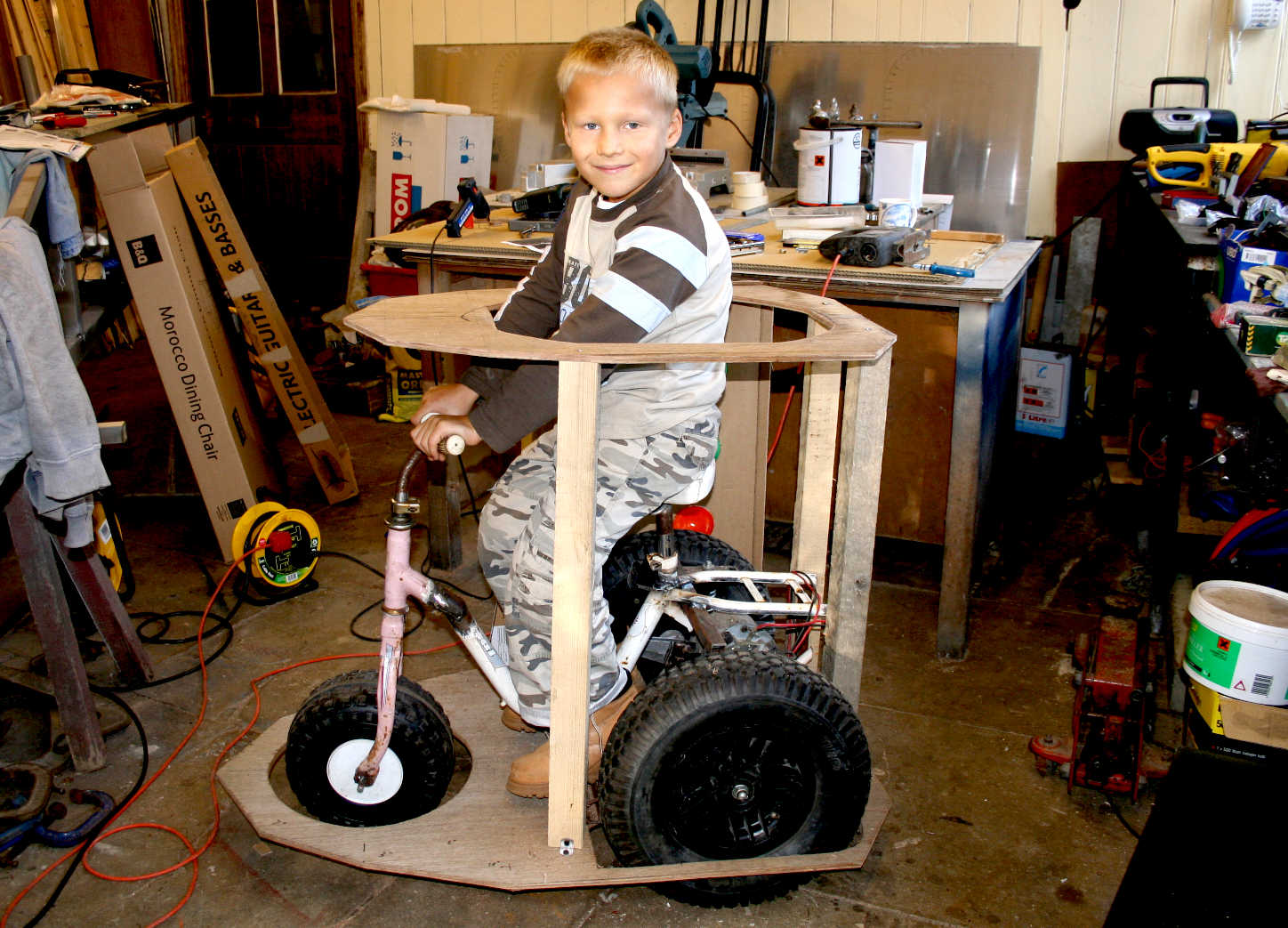
Dalek
under construction at Herstmonceux Museum workshops, a young chap
testing the steering and seating
SERIES HISTORY
As is common in long-running series whose backstories are not mapped out and which are also the product of many different writers over the course of years, Dalek history has seen many retroactive changes and these have caused some continuity problems. When the Daleks first appeared in The Daleks (1963), they were the product of a brief
nuclear war between the Dal and Thal races. However, in 1975, Terry Nation revised the Daleks' origins in the serial Genesis of the Daleks, where the Dals were now called Kaleds (an anagram of Dalek), and the Dalek design was attributed to one man, the crippled Kaled chief scientist and evil genius Davros.
Also, instead of a short nuclear exchange, the Kaled-Thal war was portrayed as a generations-long war of attrition, fought with nuclear, biological and chemical weapons. The resulting mutations from the fallout were accelerated by Davros and placed in tank-like "travel machines" whose design was based on his own life-support chair.
Genesis of the Daleks marked a new era for the species, with most of their previous history either forgotten or barely referred to again. Future stories, which followed a rough story arc, would also focus more on Davros, much to the dissatisfaction of some fans who felt that the Daleks should take centre stage, rather than becoming mere minions of their creator.
Davros made his last televised appearance in the serial Remembrance of the Daleks (1988). Remembrance of the Daleks also marked the last on-screen appearance of the Daleks in the context of the programme until 2005, save for charity specials like Doctor Who and the Curse of Fatal Death and the use of Dalek voices in the Doctor Who television movie in 1996.
The Daleks returned in the 2005 series. Dalek, written by Rob Shearman, the sixth episode of the new series, was broadcast on BBC One on 30 April, 2005. The new Dalek exhibited abilities not seen before, including a swivelling mid-section that allowed it a 360-degree field of fire and a force field that dissolved bullets before they struck it. In addition to the ability to fly, it was also able to regenerate itself by means of absorbing electrical power and the
DNA of a time traveller. The "plunger" manipulator arm was also able to crush a man's skull in addition to the technology interfacing abilities shown by earlier models. A more sophisticated model of the Dalek mutant was also shown. This Dalek was apparently the sole survivor of a Time War that had destroyed both the Daleks and the Time Lords.
The two-part 2005 series finale, comprising Bad Wolf and The Parting of the Ways saw the return of the Dalek Emperor, who had also survived the Time War and had rebuilt the Dalek race. This Emperor came to see itself as a god, and built its new society around the Daleks' worship of itself. At the end of the story, the Daleks and their fleet were reduced to atoms.
The production team has stated that the Daleks will face the Tenth Doctor at some point, but not in the 2006 series.
CULTURE
Daleks have little to no individual personalities and a strict command structure, conditioned to obey superior orders without question. Ultimately, the most fundamental feature of Dalek culture and psychology is an unquestioned belief in the superiority of the Daleks. Other species are either to be exterminated immediately, or enslaved and then exterminated later once they are no longer necessary. The default directive of a Dalek is to destroy all non-Dalek lifeforms.
This belief is thought to be the reason why Daleks have never significantly modified their mechanical shell's designs to overcome its obvious physical limitations; any such modification would deviate from the Dalek ideal, and therefore must be inferior and deserving of extermination. The schism between the Renegade and Imperial Daleks is a prime example of this, with each faction considering the other to be a perversion despite the relatively minor differences between them. It also means, however, that Daleks are intolerant of such "contamination" even within themselves, as shown in Dalek and in the Big Finish Productions audio play The Mutant Phase.
Another offshoot of this superiority complex is their complete ruthlessness and lack of compassion. It is because of this that it is nearly impossible to negotiate or reason with a Dalek and it is this single-mindedness that makes them so dangerous and not to be underestimated. However, their reliance on logic and machinery is also a weakness that they recognize. As a result, they also make use of non-Dalek species to compensate for these shortcomings.
As noted above, in The Parting of the Ways, the Daleks that were resurrected through the manipulation and mutation of human
genetic material by the Dalek Emperor were religious fanatics that worshiped the Emperor as their god.
Although the Daleks are well known for their disregard of due process, there have been two occasions on which they have taken enemies back to Skaro for a "trial" rather than killing them on the spot; the first was their creator Davros in Revelation of the Daleks, and the second was the renegade Time Lord known as the Master in the Doctor Who television movie. Neither trial occurred on-screen, so it is not clear what was actually involved. The Master's trial presumably took place before the destruction of Skaro. The reasons for the Master's trial, and why the Doctor would be asked to retrieve the Master's remains, have never been explained on screen.
The spin-off novels contain several (tongue-in-cheek) mentions of Dalek poetry (and an anecdote about an opera based thereupon, which was lost to posterity when the entire cast was exterminated on opening night). Two stanzas are given in the novel The Also People by Ben Aaronovitch. Some of the more elaborate Dalek battlecries have an almost poetic quality about them (for example, "Seek and Locate! Locate and Destroy! Destroy and Rejoice!" from the televised story The Chase). In an alternate reality portrayed in Big Finish Productions audio adventure The Time of the Daleks, the Daleks show a fondness for the works of Shakespeare.
Due to their frequent defeats by the Doctor, he has become a sort of bogeyman in Dalek culture. They have standing orders to capture or exterminate the Doctor on sight, and are occasionally able to identify him despite his regenerations. This is probably not an innate ability, but rather because of good record keeping. In the comic strips and novels the Daleks know the Doctor as the Ka Faraq Gatri, ("The Bringer of Darkness" or "Destroyer of Worlds") (this was first established in the novelisation of Remembrance of the Daleks by Ben Aaronovitch). In The Parting of the Ways, the Doctor claims that the Daleks call him "The Oncoming Storm" — this name was used by the Draconians to refer to the Doctor in the Virgin New Adventures novel Love and War by Paul Cornell.
The Doctor, in turn, has grown to be almost monomaniacal in his belief that the Daleks are completely evil and unworthy of trust or compassion. This contrasts with some of the Doctor's earlier dealings with the Daleks, for example the Second Doctor's attempt to instil a "human factor" in Daleks in The Evil of the Daleks and the Fourth Doctor's hesitation when presented with the opportunity to destroy the Daleks at the point of their creation in Genesis of the Daleks. It was his conviction of the irredeemability of the Daleks that motivated a venomous outburst by the Doctor in Dalek, leading the lone mutant in that episode to observe that the Doctor "would make a good Dalek."
OTHER APPEARANCES
Two Doctor Who movies starring Peter Cushing (wonderful) featured the Daleks as the main villains: Dr. Who and the Daleks, and Daleks - Invasion Earth 2150 AD, based on the
television serials The Daleks and The Dalek Invasion of Earth, respectively. However, the movies were not straight remakes. Cushing's Doctor is not an alien, but a human
inventor, and is literally named "Doctor Who." The movies used brand new Dalek props, based closely on the original design but with a wider range of colours. Originally, the movie Daleks were supposed to shoot jets of flame, but this was thought to be too graphic for children, so their weapons emitted jets of deadly vapour instead.
Nation also authorised the publication of the comic strip The Daleks in the comic TV Century 21. The one-page strip (written by David Whitaker but credited to Nation) featured the Daleks as protagonists and "heroes", and continued for two years, from their creation of the mechanised Daleks by the humanoid Dalek scientist Yarvelling to their eventual discovery in the ruins of a crashed space-liner of the co-ordinates for Earth, which they proposed to invade. Although much of the material in these strips directly contradicted what was shown on television later, some concepts like the Daleks using humanoid duplicates and the design of the Dalek Emperor did show up later on in the programme. In 1994, the UK arm of Marvel Comics reprinted all the TV 21 strips in a collected edition titled The Dalek Chronicles.
Marvel UK was publishing Doctor Who Magazine at the time, which included comic strip stories in its pages. Aside from meeting up with the Doctor in them, the DWM strips also introduced a new nemesis for the Daleks, the Dalek Killer named Abslom Daak. Daak was a convicted criminal in the 25th century who was given the choice between execution and being sent on a suicide mission against the Daleks. He chose the latter and, when the woman he loved was killed by the Daleks, made it his life's purpose to kill every Dalek he came across.
The Daleks' popularity extended to books, stage shows and television programmes. Daleks have been the subject of many parodies, including Spike Milligan's "Pakistani Dalek" sketch, and Victor Lewis-Smith's gay Daleks. To an extent Doctor Who itself has also parodied the Daleks from time to time. In 2002, BBC Worldwide published The Dalek Survival Guide, a parody of The Worst-Case Scenario Survival Handbooks. The Daleks have also appeared in the Dalek Empire series of audio plays by Big Finish Productions, of which three mini-series of 4 CDs each have so far been produced and saw the return of the original Dalek Emperor. They have also returned to bedevil the Doctor in Big Finish's Doctor Who line of audio plays.
In the 2003 film Looney Tunes: Back In Action, two Cushing movie-style Daleks made a cameo appearance in the "Area 52" segment amidst many famous "old-time" movie monsters. A Dalek also appears (along with Robby the Robot and the Lost in
Space robot) in a 2005 television advertisement for the Australian ANZ Bank. In the Red Dwarf A-Z (a collection of popular Red Dwarf gags, with commentaries by famous fans and the cast and crew), two Daleks are shown (in the Exterminate section, of course), arguing that all Earth television is human propaganda, and the works more commonly attributed to
William Shakespeare and Ludwig van Beethoven were actually written by Daleks. After this one of them begins talking about past episodes of Red Dwarf, and is promptly exterminated for the crime of "not behaving like a true Dalek."

Fitting
plastic spheres to a cardboard body panel in the workshop at
Herstmonceux Museum
MERCHANDISING
The BBC approached Roger Tuckwell, an Australian entrepreneur who was handling product merchandising for other BBC shows, and asked him to do the same for the Daleks and Doctor Who. Tuckwell created a glossy sales brochure that sparked off a Dalek craze, dubbed "Dalekmania" by the press, which peaked around the time The Chase aired in 1965.
The first Dalek toys from Louis Marx & Co. appeared that year, along with toys of the Mechanoids (robotic foes of the Daleks introduced in the same serials). The Mechanoids were created with the expectation that they would become as popular as Daleks, but they were not as successful. Other unsuccessful BBC attempts to create a "replacement" for the Daleks, or at least duplicate their popularity included the Voord (The Keys of Marinus), the Krotons (The Krotons) and the Quarks (The Dominators). Also unsuccessful were Dalek toys made of
rubber.
At the height of the Daleks' popularity, apart from toy replicas, there were also Dalek construction kits, Dalek board games and activity sets, Dalek slide projectors for children and even Dalek playsuits made from
PVC. There were collectible cards, stickers, toy guns, music singles, punching bags and many other items. Between 1963 and 1965, the BBC published three annuals with short stories and comic strips featuring the Daleks, written by Whitaker and Nation. The Dalek Annual was revived in 1976 and 1977, with stories and selected reprints from the TV 21 comic strip.
In the 1970s, Palitoy released a Talking Dalek which could utter standard Dalek phrases such as "You will obey!" and "Exterminate!" Later, model kits of other Dalek-related characters like Davros, the Supreme Dalek and Gold Daleks were also released. In 2001 a new range of talking Daleks were produced, along with a talking Cyberman and a talking Davros.
The Daleks have featured in computer games since the 1980s, beginning with an unlicensed modification of the Robots game called Daleks. However, the game uses Daleks only as generic monsters, with no Dalek-specific features. Licensed Doctor Who games featuring Daleks include 1984's The Key to Time, a text adventure game for the ZX Spectrum. Daleks also appeared in minor roles or as thinly disguised versions in other, minor games throughout the 80s, but did not feature as central adversaries in a licensed game until 1992, when Admiral Software published Dalek Attack. The game allowed the player to play various Doctors or companions, running them through several environments to defeat the Daleks. In 1998 the BBC released a Doctor Who screensaver done in Macromedia Shockwave which had a built-in minigame, where the player controlled K-9 battling the Daleks through seven increasingly difficult levels.
There were a few unauthorised Dalek games that can be played online, such as the Java applet game Daleks! a Macromedia Flash game, Daleks — Dissolution Earth, and a modification for Half-Life, Dalek Unbidden. Conversely, an authorised online game is The Last Dalek, a Flash game created by New Media Collective for the BBC. It is based on the 2005 episode and can be played at the official BBC Doctor Who website.
DALEK INVASION OF EARTH SCI-FI TV SERIES
The Dalek Invasion of Earth is a serial in the British science fiction television series Doctor Who, which originally aired in six weekly parts from November 21 to December 26, 1964.
SYNOPSIS
The First Doctor has brought his companions home to Earth at last, but two hundred years in their future. Trapped in a strangely quiet and deserted London, the travellers discover that
Earth has been conquered by their old enemies - the Daleks.
THE PLOT
A man staggers towards the River Thames, wearing ragged clothes and a strange metal helmet. He screams, tearing the straps off the helmet, walks into the river and drowns himself. Near the same spot, the TARDIS materialises, the Doctor surmising from the surroundings that they have landed in London. Ian and Barbara are delighted they have returned home at last, but it is a curiously silent and deserted London. The Doctor is concerned about the decay they see around them and wonders about what year it is, fearing that it is nowhere near Ian and Barbara's time. Susan tries to look over a wall, but slips and twists her ankle, at the same time that the bridge under which the TARDIS has materialised collapses, burying the TARDIS and blocking the travellers' access to it. The Doctor and Ian decide to look around in a nearby warehouse for tools to help unblock the TARDIS door. Barbara remains behind to look after Susan.
Exploring the abandoned warehouse, Ian and the Doctor are unaware they are being watched. From a window, Ian spies
Battersea Power Station with its chimneys damaged, while the Doctor finds a calendar marked 2164. Barbara, who went to the river to soak a handkerchief for Susan's ankle, returns to find her gone and a dirty-faced man there instead. The man tells her that they have to get out of there before they get killed, and that Susan has been taken by someone called Tyler. He urges her to follow as the sound of automatic fire is heard in the distance. Meanwhile, in the warehouse, the Doctor and Ian stumble across a corpse, wearing the same strange helmet seen earlier. They also find an electronic receiver attached to the helmet and a whip on the body, and discover that the man has been stabbed to death. They decide to return to the others and spy a flying saucer hovering over the city.
Barbara is still following the man across the ruins of London. Tyler carries Susan down a flight of steps into an empty Underground station as Barbara catches up. Susan and Barbara demand that they find the others, but Tyler says that there is no time. Tyler activates a secret panel and David Campbell emerges from it, telling Tyler that he had a struggle with a Roboman and that they will have to tell Dortmun to change the storehouse. He also reveals that he saw the Doctor and Ian in the warehouse but thought they were enemies. Dortmun, a man in a wheelchair, arrives, and Tyler tells him that a saucer has landed at the heliport, and Dortmun says that this time they will be ready for "them". Dortmun is glad to see Susan and Barbara, as extra sets of hands, especially since Barbara can cook. David goes to find the Doctor and Ian. Dortmun asks him not to be long as they need to go through the attack plans. Tyler takes Susan and Barbara below while Dortmun stays on watch, armed only with a knife.
Ian and the Doctor have arrived back at the TARDIS to find the women gone. Ian finds a poster forbidding the dumping of bodies in the river and muses, "Bring out your dead..." Was there a plague in the city? David spots them from a window but he also sees several Robomen converging on their position. The Doctor and Ian find themselves surrounded, but the Robomen only tell them to stop in flat tones. The two try and run for it, but turn only to see, rising from the
River
Thames, the distinctive form of a Dalek.
The Dalek orders that the Doctor and Ian be brought to the landing area, and warn the Doctor that resistance is useless and that they have already conquered the Earth. In the resistance base, the humans listen to Dalek propaganda broadcasts demanding their surrender. A young woman called Jenny tends to Susan's ankle while Barbara prepares food. Tyler and Dortmun debate about whether they are capable of attacking the Dalek saucer with the numbers they have. Dortmun shows off a new acid bomb that he has created, which he is confident will shatter the Dalek casings. David returns, reporting the capture of the Doctor and Ian. They have been taken to the heliport at Chelsea.
Ian is confused, as they saw the Daleks being destroyed on Skaro. The Doctor explains that Skaro was a million years from the present — what they are witnessing is the middle period of Dalek history. Dalek guards usher the prisoners into the saucer. One human tries to escape and is exterminated. Back in the base, David explains that the Daleks operate on some of their human prisoners and turn them into Robomen, but the transfer operation is unstable and eventually the Robomen go insane and turn suicidal. The saucer is where the transfer takes place. On the saucer, the Doctor and Ian are put in a cell together with another prisoner, Craddock. Ian asks him how the invasion happened. Ten years before, meteorites brought a plague to Earth, splitting the Earth into small communities and unable to resist six months later when the Dalek saucers landed. Some were turned into Robomen, others destroyed or sent to the mining areas in Bedfordshire. Craddock does not know, however, what the
Daleks want out of the ground.
The resistance plans the assault. Barbara suggests using the Robomen helmets as a disguise to get them close enough to use Dortmun's bombs. Meanwhile, the Doctor attempts to manipulate a device inside the cell which he suspects to contain a key to the door. However, what he does not realize is that the device is an
intelligence test. The Daleks have been observing him remotely, having earlier adjudged him more intelligent that the other humans from his earlier remarks. Solving the lock confirms their assessment, and the Doctor is taken away to be robotised. The Doctor is placed on a transfer table as outside the saucer, the resistance forces gather.
Tyler's attack group arrives, disguised as Robomen and prisoners. Susan, David and Barbara start throwing bombs from a nearby building. Tyler's group enters the saucer to try and free the prisoners while outside the Daleks scramble to mount a defense. Members of the group carry the unconscious Doctor away from the transfer table rush out of the saucer with the prisoners, using the bombs to cover their escape. The bombs, however, are ineffective. Dalek blasts and gunfire mix with the chaos of dying men as they scramble away. In the confusion, Barbara is injured and Ian remains behind on the saucer. Tyler is separated from the Doctor — he tells Dortmun back at the base that he is going to search for survivors of the raid and then leave London. Dortmun wants to go to the Civic Transport Museum, another gathering place, to get supplies so he can continue working on his bombs. Barbara and Jenny agree to go with him.
In the saucer, the Black Dalek relays an order from Supreme Command to destroy London with firebombs. The saucer lifts off, on its way to the mines. Ian emerges from his hiding place, only to bump into a robotised Craddock, who is escorting a prisoner for transfer. Ian struggles with Craddock, who stumbles against the transfer machinery and is electrocuted. The man introduces himself as Larry — he had stolen aboard the saucer in order to hitch a ride to Bedfordshire to find his brother. They get rid of Craddock's body via a disposal chute.
David and Susan hide from Dalek patrols, and listen in horror as the sounds of extermination echo around them. Susan wishes she could just go back to the TARDIS and get out of here, and suggests that she could persuade her grandfather to take David along. David tells her that running away does not solve all problems, and besides, Earth is his planet and he cannot abandon it. Susan thinks about how she has never had a place she could call home or her own identity. David says that someday she will. Suddenly, they hear a noise — Baker, carrying the drugged Doctor. Baker says he will be heading for the Cornish coast, but, just as he leaves the others, he is intercepted and exterminated by a Dalek patrol.
On the streets of London, deserted except for Daleks, Jenny, Barbara and Dortmun avoid the patrols and make it to the museum. There Dortmun finds his notes and determines the fault was not with the bombs but with the dalekanium casings of the Daleks. He comes up with a new formula for the acid bomb, and wants Barbara to take his notes to the Doctor. Barbara tells him he can give it to the Doctor himself, but once she leaves the room, Dortmun leaves his notes behind and goes outside to try the new bombs against the Daleks himself. He calls out defiantly to the Daleks, throwing a bomb at them as they exterminate him. However, the new bomb fails to make an impact. Jenny and Barbara make their escape.
The Doctor begins to get feeling back in his legs. Susan tells him that David suggests heading North to meet with a resistance group there but the Doctor says that he they should try to reach the TARDIS, tetchily observing that Susan seems to trust David's word over his. Susan protests that it is simply because David knows this time better. David returns, saying that there are patrols everywhere, and asks the Doctor for his advice as he is the senior member of the party. Somewhat mollified by the gesture of respect, the Doctor "suggests" to David that they make their way North. Susan is pleased. Hidden in the saucer, Larry tells Ian of his brother Phil's theory that the Daleks want the magnetic core of Earth. The saucer finally lands and the Daleks disembark with their new workers and the Roboman guards. Ian and Larry leave through the disposal chute and make for the nearest tunnel. Back in London, two Robomen place a Dalek firebomb near the Doctor, Susan and David's hiding place, and it begins to tick down.
The Doctor passes out, leaving David and Susan to defuse the firebomb on their own. David uses acid from one of Dortmun's bombs to burn through the casing, and removes the timing mechanism before it can trigger the explosive. David suggests they leave the Doctor behind for the moment while they search for a way through the sewers out of London. Susan does not like the idea of leaving the Doctor alone but David says they have no choice. Meanwhile, Barbara and Jenny fix up a lorry from the museum in preparation to drive up to Bedfordshire. There, Larry and Phil are moving through the countryside, spotting a group of human
slaves pulling a carriage of metal parts towards a mine shaft and hearing the sounds of machinery. Trying to get under cover, they meet a man called Wells, who thinks they are escaped workers. He tries to cover for them, however, when a Roboman comes to take them for selection to be robotized. Ian and Larry help Wells when the Roboman attacks him, and knocks the Roboman out. Wells tells them he was here to meet Ashton, a black marketeer. Ian wants to meet Ashton, hoping he has a way to get him back to London. Wells tells Ian that the Daleks have destroyed the city.
In London, Barbara and Jenny ride out of the museum in the lorry, past Dortmun's corpse. They run a road block, Barbara crashing the lorry through the Daleks, but their position is reported back to the saucer, which gives orders to intercept them. Jenny and Barbara manage to leap out of the lorry before it is destroyed by the saucer. David and Susan move through the sewers, where they meet Tyler, who warns them of alligators in the sewers. Susan hopes that she will never become as cynical as Tyler, but David says that one day it will be all over and they can rebuild the planet from the start. Susan finds the idea of a fresh start exciting. While exploring, Susan nearly falls into the jaws of an alligator, but Tyler and David manage to rescue her. They climb out of the sewers, Tyler having found the Doctor who has now recovered. In Bedfordshire, Larry and Ian avoid the monstrous Slyther, the pet of the Black Dalek, and while hiding, meet Ashton. Ian asks if Ashton can take him to London, but Ashton refuses unless Ian can pay in
gold or other precious metals. Wells arrives, trading
jewellery for food, but the Slyther attacks as they are eating. Ashton is killed, while the Slyther approaches Larry and Ian, who are trapped on the edge of a sheer drop.
The two jump into a mining bucket suspended over the pit, and although the Slyther tries to jump after them, Ian hits it with a rock and causes it to fall to its death. Before Ian and Larry can climb out of the bucket, it starts to descend. In London, Robomen pursue the Doctor and his party back into the sewers. Tyler and David lay an ambush, and manage to subdue them. Meanwhile, Jenny and Barbara find a hovel in the countryside with two women, seeking shelter from a
storm. The women are left alone by the Daleks because they make clothes for the slave workers in exchange for food. Barbara offers them food in exchange for staying the night. The older woman sends the younger one to deliver clothes, but she has actually gone to bring the Daleks, who capture Jenny and Barbara.
Ian and Larry finally reach the bottom of the shaft, and jump down the last twelve feet before the bucket tips over. Larry injures his knee as he falls, however. As he hides, Ian looks around, puzzled that the mine only seems to be made for shifting rocks and not processing ore. Larry repeats his brother's theory that the Daleks are after the Earth's core. Trying to blend in with a working party, they are confronted by a Roboman — Larry's brother Phil. Larry pleads with Phil, trying to make him remember who he is, but Phil prepares to shoot them. Larry tells Ian to run as Phil shoots, mortally wounding Larry even as Larry strangles him. Both die, with Phil's last word being a strangled, "Larry..." Alarms sound as the workers seize their chance for freedom.
In the countryside, Susan and David share a tender moment around a campfire, kissing before the Doctor and Tyler return. The Doctor has deduced the reasons why the Daleks are here — something deep beneath the Earth, tampering with the forces of creation. Ian makes his way deeper into the mine, noticing Jenny and Barbara, who have joined a working party. Jenny is in despair, but Barbara says they must find the control room, as that would be what the Doctor would do. Ian keeps hidden, but tells Wells to pass word to Barbara that he is here. Barbara tells the Daleks that the rebels are planning an attack, and shows them Dortmun's notes. She asks to speak to someone in authority and they agree to take her to the Black Dalek. Meanwhile, the Daleks report to the Black Dalek that they have almost reached the outer crust of the core. All that remains is to set up and the penetration explosive. Once the core is removed, they will replace it with a power system that will allow the Daleks to pilot the planet anywhere in the universe. Unfortunately, Ian has chosen the penetration device as a hiding place, and it is moving into position to be dropped down the main shaft.
Ian disconnects some wires inside the casing, stopping its descent. The Robomen start pulling it back up the shaft, while Ian manages to open a panel at the bottom of the casing and climb out. A Dalek spots him, however, and severs the rope, causing Ian to slide down the shaft and fall against a door, which knocks him senseless. At that point, Barbara and Jenny are escorted into the Dalek control room. The Black Dalek orders that all humans be moved to the lower galleries to be exterminated in the final blast. The Daleks relay the orders to the Robomen through a microphone, which Barbara notices. The Black Dalek interrogates Barbara and she tries to stall by telling them of an elaborate mutiny that involves Red Indians, the Boston Tea Party, Robert E. Lee and Hannibal, panicking the Daleks momentarily but not enough — she is recaptured when she tries to use the microphone. She and Jenny are immobilized in clamps to await destruction when the bomb explodes.
Outside, the Doctor tells Susan and David to destroy an aerial on the far side of the mine with Dortmun's bombs. He and Tyler will go into the mine itself. Ian regains consciousness outside the lower gallery where the Robomen are hauling
timber. When they leave, he puts some of these spars into the bomb shaft, where it stops the progress of the bomb before it can reach the crust. The Daleks are unaware of this, however, and evacuate. The Doctor neutralises the warning system and he and Tyler make their way into the control room, where they free Jenny and Barbara. He explains that David and Susan's mission will immobilize the Daleks. As the Daleks detect the Doctor's presence in the control room, a patrol approaches, but David and Susan succeed and the Daleks stop in their tracks. Barbara and Susan use the microphone to tell the Robomen to turn against the Daleks. Human workers and Robomen break into open revolt and stream out of the mine.
Ian is reunited with the others. From where the bomb has stopped, it will not succeed in penetrating the crust but will still produce a gigantic explosion. As they reach higher ground, the bomb explodes, making the ground around the mine collapse and cause an entirely new phenomenon — a
volcanic eruption in England. The Dalek saucer is caught in the upward thrust of the explosion. The invasion is over.
Back in London, the resistance helps the Doctor uncover the TARDIS as the chimes of Big Ben herald a new beginning for mankind. Susan is saddened at the prospect of leaving, and the Doctor seems to sense this. He goes into the TARDIS while Susan goes to say good-bye to David, who tells Ian he wants to work the land, see things grow again. Barbara takes Ian back into the TARDIS so they can leave Susan and David alone. David tells Susan that he loves her and asks to stay and marry him, offering her the place and identity she has been yearning for. Susan admits she loves him too, but she also needs to look after her grandfather, and begs him not to make her choose between them. The Doctor, having heard all this, makes Susan's choice for her. He double-locks the doors of the TARDIS, preventing Susan from entering. He tells Susan through the scanner that she will always be his grandchild, but she is a woman now, and he wants her to have a home; David will take care of her. Saying one last good-bye and saying he will one day return, he makes the TARDIS dematerialise.
Susan looks forlornly around the empty space where the TARDIS used to be, fingering the TARDIS key on the chain around her neck. David reaches his hand out to her and she takes it, dropping the key onto the ground and walking away.

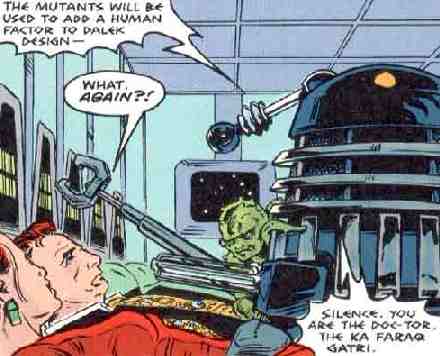
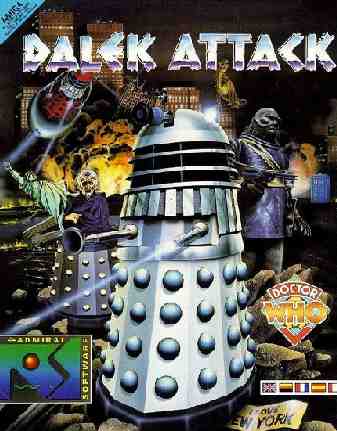

1.
Art
Gallery - Collection of paintings, pictures, graphics, sculptures,
wooden carvings & exotic glassware (coming soon)
2.
Archives - Historic documents library, patents, trademarks,
copyright, films, catalogued legal papers & letters (coming soon)
3. An
Edwardian ice well, throwback to the days before refrigeration (coming
soon)
4.
A large underground (condensation/cooling) and water storage chamber for
ice making (coming soon)
5.
The world's smallest water
basin, test tank for model boats & ships to 1:20 scale
6.
World's smallest
wind tunnel, vehicle drag measuring instrument using electronic
strain-gauges
7.
Three
PV boat models,
Navigator, SWATH & 2 cats + route map prior to Swiss PlanetSolar
8.
Seavax, the ocean cleanup
proof of concept prototype from 2016
9.
AmphiMax, radio controlled (working) beach launching & recovery
vehicle for SeaVax
10.
Anthony the
most dangerous giant
Australian bulldog ant, 300 times normal size - Making
Ant's Cart
11.
EV - FCEV refueling station
model in 1:20 scale
12.
The only working
(fully functional) water well in Herstmonceux village
13.
The fountain of youth, Cleopatra inspired statue supplied from natural well water
drawn on site (coming soon)
14.
Second World War, 'Anderson Inspired,' bomb proof shelter constructed by Major Charles de Roemer
15.
City
sports FCEV-BEV, hydrogen gull wing proof of concept DC50 electric car
16.
Land speed record car: Bluebird-Electric BE1 (original 1st) with battery
cartridge exchange
17.
Land speed record car: Bluebird-Electric BE2 (original 2nd) with cartridge
exchange
18.
A complete mummified squirrel, found when re-roofing the Museum June
2017 (coming soon)
19.
A fully operational, and restored VW Kombi van dating from 1978
(historic vehicle)
20.
BMW i3, battery electric vehicle hybrid, with onboard generator range
extender
21.
Solar panel,
and battery energy storage systems facing north-south and east-west
22.
A hornet's nest found on site & preserved in 2016 (reported as
[Asian] invasive species, to be safe)
23.
Three sewing machines, including an antique Singer and a Brother
industrial. (coming soon)
24. Adventure climbing frames for children (back to nature)
Swiss Family Robinson (under review)
25.
'Elizabeth
Swann' proof of concept model 1:20 scale hydrogen powered trimaran
26.
Holm
oaks, planting and growing trees from acorns on site, re-wilding in
Sussex
27.
Robotics, mechatronics, electronics and animatronics display - the
steel frame, head-jaws, &
drives
of Anthony (coming soon)
28.
Dalek - Full size, drivable working model of the famous
Doctor Who BBC TV series,
and Peter Cushing film
LINKS:
Cast
and Crew list, on the BBC website
Photonovel
of episode 2 of The Daleks' Master Plan on the BBC website
Project
Dalek (http://www.projectdalek.co.uk/)
- build your own Dalek
john@projectdalek.co.uk
Dalek
6388 (http://www.dalek6388.co.uk/)
- about the various Dalek props built for the series
Science
fiction citations
- Oxford English
Dictionary citation of "dalek"
Dalek
Links
-
the Web's most comprehensive listing of Dalek Web sites
Project
Dalek
- build your own Dalek
Dalek
City
-
Dalek Building guides
Dalek
6388
-
about the various Dalek props built for the series
Doctor
Who Collectibles: An Annotated Bibliography
The
Last Dalek
-
Flash game by New Media Collective, on the BBC website
Dalek
3D Resource
-
General information and 3D models
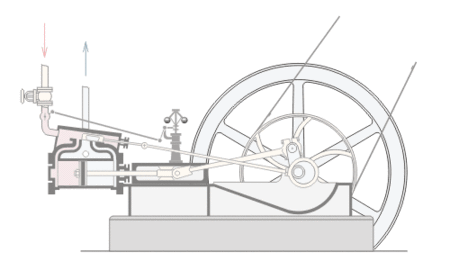
|
